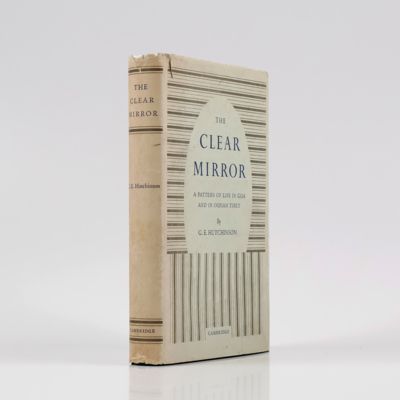On the ecology of lakes and the travel inbetween
Hutchinson, G. E.
The Clear Mirror. A pattern of life in Goa and in Indian Tibet.
Published
1936
Item ID
77658
€250.00
Cambridge, at the University Press, 1936. 8vo (22.2 x 14.1 cm). xi, 171 pp.; 13 b/w photographic plates, one map. Publisher's green cloth with green title on the front board and spine; top edge green. In original printed dust jacket and transparent sleeve.
A seldom-seen travelogue and rare piece of "Indiana", written during the Yale North India Expedition of 1932. Interesting because it describes regions now totally altered by mass tourism (Goa), or still less-travelled (Indian Tibet). The author, George Evelyn Hutchinson (1903-1991) was a British ecologist, invertebrate zoologist and malacologist, sometimes described as the "father of modern ecology." This is his first book. "He contributed for more than sixty years to the fields of limnology, systems ecology, radiation ecology, entomology, genetics, biogeochemistry, a mathematical theory of population growth, art history, philosophy, religion, and anthropology. He is known as one of the first to combine ecology with mathematics. He became an international expert on lakes and wrote the four-volume Treatise on Limnology in 1957. Although born in England, he spent nearly his entire professional life at Yale University in the United States where he was Sterling Professor of Zoology. After graduating, he went to Italy to study octopuses. Next he travelled to South Africa where he discovered the field of limnology or the study of freshwater systems, on the shallow lakes near Cape Town. He travelled widely, reaching underexplored parts of the world and writing his first book on the ecology of high-elevation lakes in India. In 1932 Hutchinson joined the Yale North India Expedition. He wanted to be the first to make ecological observations of a high-altitude lake, and to compare these with lower-altitude lakes. The work yielded insights into biogeography and new data on high elevation limnology. Most lakes had no fish, and crustaceans were the top predators. In letters to his wife, the biologist and malacologist (specialized in cephalopods) Grace Evelyn Pickford (1902-1986), he described the different water chemistry from the Indian lakes to the South African lakes. He collected hundreds of specimens for analysis by specialists. This expedition provided the material for his first book, The Clear Mirror, in which he described the colors, organisms, ecology, and the people of the Ladakh. Hutchinson is also recognized as being the first to use radioisotopes as tracers in field experiments. In doing so he along with his graduate student Vaughan Bowen, are credited with creating Radiation Ecology, a brand new major field of ecology. Hutchinson and his graduate students intellectualized American ecology by 'forcing its practitioners to confront all of the processes that maintain to change ecological systems, whether these processes were biological, physical or geological'. Hutchinson also raised the idea of climate change 30 years before the problem became popular. He taught his students as early as 1947 that the increase in atmospheric carbon dioxide would lead to a global temperature increase. He considered the causes and preventatives for extinction, resource management, and the social anthropology of endangered cultures decades before they were attracting attention as crises" (Wikipedia).
read more
Rare in the original dust jacket, and without any marking or spotting. Dust jacket spine top with a few short tears, small part of the top edge discoloured, but otherwise near mint. A superb condition that is very rare indeed.
read less




